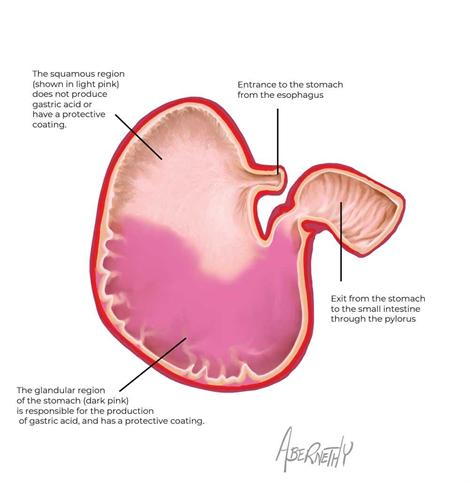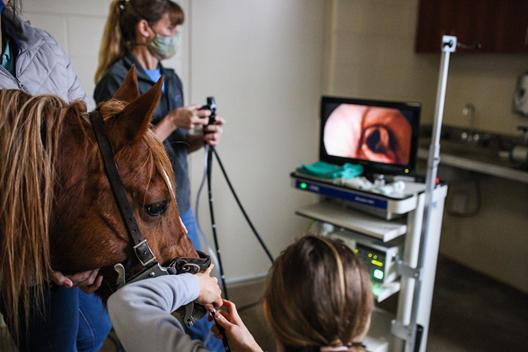De-bunking Gastric Ulcers
- posted: Feb. 17, 2022
The equine stomach:
2 portions: squamous (upper) and glandular (lower), separated by the margo plicatus. The glandular portion secretes acid and enzymes to break down food, and therefore has a protective coating against the acid. The top portion (squamous) is designed for mixing food and does not have as much acid protection.

What are gastric ulcers?
Erosions or sores in the stomach, affecting up to 60-90% of horses in some studies.
Predisposing factors:
- Stress: travel, new environment, illness, competitions
- Intense training/exercise: Exercise increases gastric acid production and decreases blood flow to the gastrointestinal tract.
- Intermittent feeding: Prolonged period of time (more than 6 hours) without access to forage: Horses evolved as grazing animals, therefore the stomach continuously produces acid. Without forage to be broken down, the acids can overwhelm the stomach lining.
- Housing: Horses confined in stalls unable to socialize with other horses, with restricted access to pasture are more likely to be stressed.
Clinical signs:
- Change in attitude
- Low grade chronic colic
- Pawing
- Teeth grinding
- Girthiness
- Weight loss
- Dull
- Poor haircoat
Diagnosis:
Endoscopy: Placing a small camera up the nostril, through nasal passages and pharynx, into esophagus, and finally into the stomach. Horses must be fasted at least 12 hours prior to the procedure for the stomach to be empty enough to visualize the mucosa. A tentative diagnosis can be made based on response to treatment.

Treatment:
- Main goal is suppressing gastric acidity and maintaining pH of 4-5.
- Currently only one FDA approved pharmaceutical treatment: omeprazole (gastrogard or ulcergard). Omeprazole is a proton pump inhibitor, which means it works by decreasing the amount of acid produced. It’s given once daily 30-60 minutes before a meal, and takes a minimum of 3 days to make a clinical effect.
- Sucralfate may be added in severe or painful ulcers as it coats the lesions and provides symptomatic relief and can aid in healing.
- Misoprostol may be added in glandular stomach ulcers, as it has been shown to be superior to omeprazole and sucralfate combined at the treatment of glandular lesions.
- Antacids would need to be administered 6-12 times daily to be effective, and often are administered in feed (which is a buffer itself).
Prevention:
- Feed frequently in a hay net or on a free choice basis. Eating stimulates saliva production which is an excellent antacid.
- Feeding alfalfa hay or chaff 30 minutes prior to exercise- as both an antacid because of the calcium content and as a fiber mat to limit gastric acid splashing.
- Decrease stress, limit frequent transport and intense training.
- Decrease grain/concentrate.
- Avoid or decrease the use of NSAIDS, and if needed on a continuing basis, consider firocoxib (equioxx).
- There are many supplements that claim to prevent gastric ulcers, many of which are ineffective and lack validation. Owners should take caution to utilize products that have been validated in competent scientific studies. At the end of the day, most of these supplements will not harm your horse, but will not benefit it to the extent that appropriate pharmaceutical medication will.
- The product Smart Gut Ultra (www.smartpakequine.com) has some published evidence supporting its use to prevent worsening of non-glandular gastric ulcers (Andrews et. al. 2014). Purina Outlast is another researched supplement for gastric ulcers.
- Horses at high risk for gastric ulcers should have preventative therapy with omeprazole.
Location
Find us on the map
Browns Summit Location
5373 NC Hwy 150
Browns Summit, NC 27214, United States

